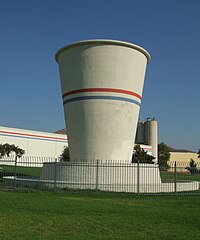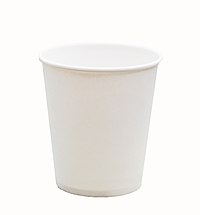Paper cup
A paper cup is a disposable cup made out of paper and often lined or coated with plastic or wax to prevent liquid from leaking out or soaking through the paper.[1][2][3] It may be made of recycled paper[4] and is widely used around the world.
History[edit]
Paper cups have been documented in imperial China, where paper was invented by 2nd century BC.[5] Paper cups were known as chih pei and were used for the serving of tea.[6] They were constructed in different sizes and colors, and were adorned with decorative designs. Textual evidence of paper cups appears in a description of the possessions of the Yu family, from the city of Hangzhou.[6]
The modern paper cup was developed in the 20th century. In the early 20th century, it was common to have shared glasses or dippers at water sources such as school faucets or water barrels in trains. This shared use caused public health concerns. One notable investigation into their use was the study by Alvin Davison, biology professor at Lafayette College, published with the sensational title “Death in School Drinking Cups” in Technical World Magazine in August 1908, based on research carried out in Easton, Pennsylvania‘s public schools. The article was reprinted and distributed by the Massachusetts State Board of Health in November 1909.[7]
Based on these concerns, and as paper goods (especially after the 1908 invention of the Dixie Cup) became cheaply and cleanly available, local bans were passed on the shared-use cup. One of the first railway companies to use disposable paper cups was the Lackawanna Railroad, which began using them in 1909. By 1917, the public glass had disappeared from railway carriages, replaced by paper cups even in jurisdictions where public glasses had yet to be banned.[8]
Paper cups are also employed in hospitals for health reasons. In 1942 the Massachusetts State College found in one study that the cost of using washable glasses, re-used after being sanitized, was 1.6 times the cost of using single-service paper cups.[9] These studies, as well as the reduction in the risk of cross-infection, encouraged the use of paper cups in hospitals.
Dixie cups[edit]
Dixie Cup is the brand name for a line of disposable paper cups that were first developed in the United States in 1907 by Lawrence Luellen, a lawyer in Boston, Massachusetts, who was concerned about germs being spread by people sharing glasses or dippers at public supplies of drinking water. Luellen developed an ice-cooled water-vending machine with disposable cups,[7] and with another Bostonian, Hugh Moore, embarked on an advertising campaign to educate the public and to market his machine, principally to railroad companies. Professor Davison’s study was instrumental in abolishing the public glass and opening the door for the paper cup. Soon, the devices, which would dispense cool water for one cent, became standard equipment on trains.
The Dixie Cup was first called “Health Kup”, but from 1919 it was named after a line of dolls made by Alfred Schindler’s Dixie Doll Company in New York. Success led the company, which had existed under a variety of names, to call itself the Dixie Cup Corporation and move to a factory in Wilson, Pennsylvania. Atop the factory was a large water tank in the shape of a cup.[10]
In 1957, Dixie merged with the American Can Company. The James River Corporation purchased American Can’s paper business in 1982. The assets of James River are now part of Georgia-Pacific, a subsidiary of Koch Industries, the second largest privately owned company in the United States. In 1983, production moved to a modern factory in Forks, Pennsylvania. The original factory in Wilson has sat vacant ever since. The closing of the factory also prompted Conrail to abandon the Easton & Northern railroad branch, of which Dixie Cups was the last major customer.
In 1969, the Dixie Cup logo was created by Saul Bass, a graphic designer known for his motion picture title sequences.
The coupon collector’s problem is sometimes called the Dixie cup problem.
Manufacture[edit]

The world’s largest “paper” cup in front of what was once the Lily-Tulip manufacturing company, later Sweetheart Cup Company.[11] Made of poured concrete, the cup stands about 68.1 feet (20.8 m) tall.
The base paper for paper cups are called “cup board” and are made on special multi-ply paper machines and have a barrier coating for waterproofing. The paper needs high stiffness and strong wet sizing. The cup board grades have a special design for the cup manufacturing processes. The mouth roll forming process requires good elongation properties of the board and the plastic coating. A well formed mouth roll provides good stiffness and handling properties in the cup. The basis weights of the cup boards are 170–350 g/m2.[12]
To meet hygiene requirements, paper cups are generally manufactured from virgin (non-recycled) materials.[citation needed] The one exception to this rule is when the paper cup features an extra insulating layer for heat retention, which never comes into contact with the beverage, such as a corrugated layer wrapped round a single-wall cup.
Waterproofing[edit]
Originally, paper cups for hot drinks were glued together and made waterproof by dropping a small amount of clay in the bottom of the cup, and then spinning at high speed so that clay would travel up the walls of the cup, making the paper water-resistant. However, this resulted in drinks smelling and tasting of cardboard.
Cups for cold drinks could not be treated in the same way, as condensation forms on the outside, then soaks into the board, making the cup unstable. To remedy this, cup manufacturers developed the technique of spraying both the inside and outside of the cup with wax. Clay- and wax-coated cups disappeared with the invention of polyethylene (PE)-coated cups; this process covers the surface of the board with a very thin layer of PE, waterproofing the board and welding the seams together.
Printing on paper cups[edit]
Originally paper cups were printed using rubber blocks mounted on cylinders, with a different cylinder for each colour. Registration across different colours was very difficult, but later flexography plates became available and with the use of mounting systems it became easier to register across the colours, allowing for more complex designs. Printing flexographic has become ideal for long runs and manufacturers generally use this method when producing over a million cups. Machines such as Comexi are used for this, which have been adapted to take the extra large reels that are required by paper cup manufacturers. Ink technology has also changed and where solvent-based inks were being used, water-based inks are instead being utilised. One of the side effects of solvent-based inks is that hot drink cups in particular can smell of solvent, whereas water-based inks have eliminated this problem. Other methods of printing have been used for short runs such as offset printing, which can vary from anything from 10,000 to 100,000 cups. Offset printing inks have also been developed and although in the past these were solvent based, the latest soya-based inks have reduced the danger of cups smelling. The latest development is Direct-printing, which allows printing on very small quantities, typically from 1,000 cups, and is used by companies including The Paper Cup Company offering small quantities in short lead times. Rotogravure can also be used, but this is extremely expensive and is normally only utilised for items requiring extremely high quality printing like ice cream containers.
Environmental impact[edit]
Recycling[edit]
Most paper cups are designed for a single use and then disposal. Very little recycled paper is used to make paper cups because of contamination concerns and regulations. Since most paper cups are coated with plastic (polyethylene), then both composting and recycling of paper cups is uncommon because of the difficulty in separating the polyethylene in the recycling process of said cups. As of 2016, there are only two facilities in the UK able to properly recycle PE-coated cups; in the absence of such facilities, the cups are taken to landfill, or, at best, incinerated.
A UK-based business group James Cropper have developed the world’s first facility for the effective recycling of the estimated 2.5 billion paper coffee cups used and disposed of by British businesses each year, and have become one of 14 international companies to formally join the Paper Recovery and Recycling Group (PCRRG).
James Cropper’s Reclaimed Fibre Facility was opened by HM The Queen in July 2013, and recovers both the plastic and paper from the cups; ensuring nothing is wasted from the recycling process.[13] Although paper cups are made from renewable resources (wood chips 95% by weight), paper products in a landfill might not decompose, or can release methane, if decomposed anaerobically.
A Newport Beach, CA company, Smart Planet Technologies has developed a process for modifying the polyethylene coating on paper cups and folding cartons so they are engineered for recyclability. Orange Coast College in Costa Mesa, CA has begun a program to use cups made with this technology to capture and sell the fibers to fund scholarships for their students. [14]
The manufacture of paper usually requires inorganic chemicals and creates water effluents. Paper cups may consume more non-renewable resources than cups made of polystyrene foam (whose only significant effluent is pentane).[15][16]
Paper vs plastic[edit]
A life cycle inventory of a comparison of paper vs plastic cups shows environmental effects of both with no clear winner.[17]
Polyethylene (PE) is a petroleum-based coating on paper cups that can slow down the process of biodegrading of the paper it coats.
Polylactic acid (PLA) is a biodegradable bio-plastic coating used on some paper cups. PLA is a renewable resource and is certified compostable, which means that when it biodegrades, it does not leave behind any toxic residues.[18] PLA-lined cups are thus the only paper cups which can be composted fully. All paper cups can only be recycled at a specialised treatment facility regardless of the lining.[19]
A number of cities – including Portland, Oregon — have banned XPS foam cups in take-out and fast food restaurants.[20]
Emissions[edit]
A study of one paper coffee cup with sleeve (16 ounce) shows that the CO2 emissions is about 0.11 kilograms (0.24 lb) per cup with sleeve – including paper from trees, materials, production and shipping.[21]
Habitat-loss trees used[edit]
The habitat loss from one 16 ounce paper coffee cup with a sleeve is estimated to be 0.09 square meters (0.93 square feet).[dubious ][22][unreliable source?] Over 6.5 million trees were cut down to make 16 billion paper coffee cups used by U.S. in 2006, using 4 billion US gallons (15,000,000 m3) of water and resulting in 253 million pounds (115,000,000 kg) of waste. Overall, US Americans use 58% of all paper cups worldwide, amounting to 130 billion cups.[13][unreliable source?][23][unreliable source?]
Lids[edit]
Paper cups may have various types of lids. The paper cups that are used as containers for yogurt, for example, generally have two types of lids: a plastic press-on, resealable, lid used for large “family size” containers, 250–1,000 ml (8–30 US fl oz), where not all of the yogurt may be consumed at any one time and thus the ability to re-close the container is required and heat-seal foil lids used for small “single serving” containers, 150–200 ml (5–7 US fl oz).[24]
Hot drinks sold in paper cups may come with a plastic lid, to keep the drink hot and prevent spillage. These lids have a hole through which the drink can be sipped. The plastic lids can have many features including peel back tabs, raised walls to protect the foam of gourmet hot drinks and embossed text.[25] In 2008, Starbucks introduced shaped plastic “splash sticks” to block the hole, in some of their stores, after customer complaints about hot coffee splashing through it.[26][27]
 Feenot paper cup machine
Feenot paper cup machine





